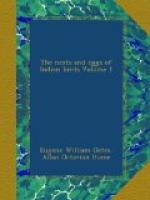“I very rarely saw the Black-headed Myna in Bombay, Poona, or Berar, but here, in Madras, it is, if anything, commoner than A. tristis.”
And Mr. J. Davidson, writing from Mysore, also confirms Jerdon’s statement; he says:—“T. pagodarum breeds here in holes in the roofs of houses as well as in trees.”
Of the breeding of this Myna in Ceylon, Colonel Legge says:—“In the northern part of Ceylon this Myna breeds in July and August, and nests, I am informed, in the holes of trees.”
Mr. A.G.R. Theobald notes that “early in August I found a nest of T. pagodarum at Ahtoor, the hill-station of the Shevaroys. It was down in the inside of a partly hollow nut-tree log, attached to a scaffolding, about 2 1/2 feet down and, say, 35 feet from the ground, and was composed of dry leaves and a few feathers. It contained three fresh eggs.”
The eggs of this Myna are, of course, glossy and spotless, and the colour varies from very pale bluish white to pale blue or greenish blue. I have never seen an egg of this species of the full clear sky-blue often exhibited by those of A. tristis, S. contra, and A. giuginianus.
The eggs vary in length from 0.86 to 1.15, and in breadth from 0.66 to 0.8; but the average of fifty-four eggs is 0.97 by 0.75.
546. Graculipica nigricollis (Payk.). The Black-necked Myna.
All that we know of the nidification of this species is contained in the following brief note by Dr. John Anderson:—
“It has much the same habits as Sturnopastor contra var. superciliaris. I found it breeding in the month of May in one of the few clumps of trees at Muangla.”
Muangla lies to the east of Bhamo.
549. Acridotheres tristis (Linn.). The Common Myna.
Acridotheres tristis (Linn.), Jerd. B. Ind.
ii, p. 325; Hume, Rough
Draft N. & E. no. 684.
The Common Myna breeds throughout the Indian Empire, alike in the plains and in the hills. A pair breed yearly in the roof of my verandah at Simla, at an elevation of 7800 feet.
They are very domestic birds, and greatly affect the habitations of man and their immediate neighbourhood. They build in roofs of houses, holes in walls, trees, and even old wells, in the earthen chatties that in some parts the natives hang out for their use (as the Americans hang boxes for the Purple Martin), and, though very rarely, once in a way on the branches of trees.
Captain Hutton says:—“This is a summer visitor in the hills, and arrives at Mussoorie with the A. fuscus, Wagl. It builds in the hole of a tree, which is lined with dry grass and feathers, and on no occasion have I ever seen a nest made on the branches of a tree composed of twigs and grass as stated by Captain Tickell.”




